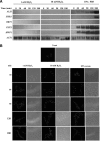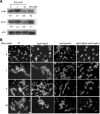A MAP kinase pathway is implicated in the pseudohyphal induction by hydrogen peroxide in Candica albicans
- PMID: 22358510
- PMCID: PMC3887715
- DOI: 10.1007/s10059-012-2244-y
A MAP kinase pathway is implicated in the pseudohyphal induction by hydrogen peroxide in Candica albicans
Abstract
Hydrogen peroxide (H(2)O(2)) functions as a ubiquitous intracellular messenger besides as an oxidative stress molecule. This dual role is based on the distinct cellular responses against different concentrations of H(2)O(2). Previously, we demonstrated that both low (> 1 mM) and high (4-10 mM) doses of exogenous H(2)O(2) induce filamentous growth with distinct cell morphology and growth rate in Candida albicans, suggesting the different transcription response. In this study, we revealed that the sub-toxic and toxic levels of H(2)O(2) indeed induced pseudohyphae, but not true hyphae. Supporting this, several hyphae-specific genes that are expressed in true hyphae induced by serum were not detected in either sub-toxic or toxic H(2)O(2) condition. A DNA microarray analysis was conducted to reveal the transcription profiles in cells treated with sub-toxic and toxic conditions of H(2)O(2). Under the sub-toxic condition, a small number of genes involved in cell proliferation and metabolism were up-regulated, whereas a large number of genes were up-regulated in the toxic condition where the genes required for growth and proliferation were selectively restricted. For pseudohyphal induction by sub-toxic H(2)O(2), Cek1 MAPK activating the transcription factor Cph1 was shown to be important. The absence of expression of several hyphae-specific genes known to be downstream targets of Cph1-signaling pathway for true hyphae formation suggests that the Cek1-mediated signaling pathway is not solely responsible for pseudohyphal formation by subtoxic H(2)O(2) and, but instead, complex networking pathway may exists by the activation of different regulators.
Figures




Similar articles
-
Transcript profiling of a MAP kinase pathway in C. albicans.Microbiol Res. 2008;163(4):380-93. doi: 10.1016/j.micres.2008.03.001. Epub 2008 May 8. Microbiol Res. 2008. PMID: 18467082
-
Lrg1 Regulates β (1,3)-Glucan Masking in Candida albicans through the Cek1 MAP Kinase Pathway.mBio. 2019 Sep 17;10(5):e01767-19. doi: 10.1128/mBio.01767-19. mBio. 2019. PMID: 31530671 Free PMC article.
-
Depletion of the mitotic kinase Cdc5p in Candida albicans results in the formation of elongated buds that switch to the hyphal fate over time in a Ume6p and Hgc1p-dependent manner.Fungal Genet Biol. 2017 Oct;107:51-66. doi: 10.1016/j.fgb.2017.08.002. Epub 2017 Aug 10. Fungal Genet Biol. 2017. PMID: 28803909
-
Hgc1-Cdc28-how much does a single protein kinase do in the regulation of hyphal development in Candida albicans?J Microbiol. 2016 Mar;54(3):170-7. doi: 10.1007/s12275-016-5550-9. Epub 2016 Feb 27. J Microbiol. 2016. PMID: 26920877 Review.
-
Growth of Candida albicans hyphae.Nat Rev Microbiol. 2011 Aug 16;9(10):737-48. doi: 10.1038/nrmicro2636. Nat Rev Microbiol. 2011. PMID: 21844880 Review.
Cited by
-
The Candida albicans biofilm gene circuit modulated at the chromatin level by a recent molecular histone innovation.PLoS Biol. 2019 Aug 9;17(8):e3000422. doi: 10.1371/journal.pbio.3000422. eCollection 2019 Aug. PLoS Biol. 2019. PMID: 31398188 Free PMC article.
-
Increased oxidative stress tolerance results in general stress tolerance in Candida albicans independently of stress-elicited morphological transitions.Folia Microbiol (Praha). 2014 Jul;59(4):333-40. doi: 10.1007/s12223-014-0305-7. Epub 2014 Jan 30. Folia Microbiol (Praha). 2014. PMID: 24477890
-
Oxidative stress response pathways in fungi.Cell Mol Life Sci. 2022 Jun 1;79(6):333. doi: 10.1007/s00018-022-04353-8. Cell Mol Life Sci. 2022. PMID: 35648225 Free PMC article. Review.
-
Role of two Nomuraea rileyi transmembrane sensors Sho1p and Sln1p in adaptation to stress due to changing culture conditions during microsclerotia development.World J Microbiol Biotechnol. 2015 Mar;31(3):477-85. doi: 10.1007/s11274-015-1801-x. Epub 2015 Jan 18. World J Microbiol Biotechnol. 2015. PMID: 25595731
-
Microbial interactions in building of communities.Mol Oral Microbiol. 2013 Apr;28(2):83-101. doi: 10.1111/omi.12012. Epub 2012 Dec 17. Mol Oral Microbiol. 2013. PMID: 23253299 Free PMC article. Review.
References
-
- Aguirre J., Rios-Momberg M., Hewitt D., Hansberg W. Reactive oxygen species and development in microbial eukaryotes. Trends Microbiol. 2005;13:111–118. - PubMed
-
- Alonso-Monge R., Roman E., Arana D.M., Prieto D., Urrialde V., Nombela C., Pal J. The Sko1 protein represses the yeast-to-hypha transition and regulates the oxidative stress response in Candida albicans. Fungal Genet. Biol. 2010;47:587–601. - PubMed
-
- Andaluz E., Ciudad T., Gomez-Raja J., Calderone R., Larriba G. Rad52 depletion in Candida albicans triggers both the DNA-damage checkpoint and filamentation accompanied by but independent of expression of hypha-specific genes. Mol. Microbiol. 2006;59:1452–1472. - PubMed
Publication types
MeSH terms
Substances
LinkOut - more resources
Full Text Sources

